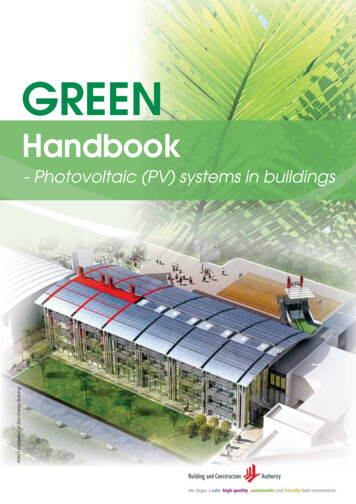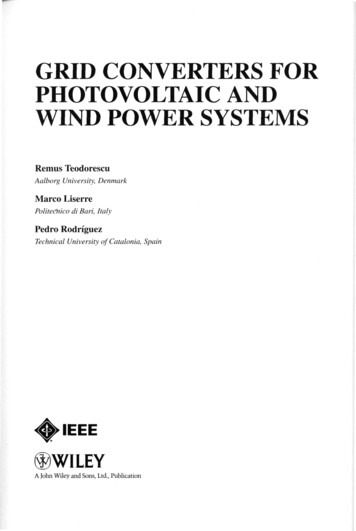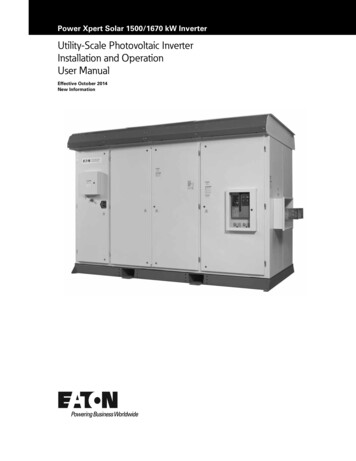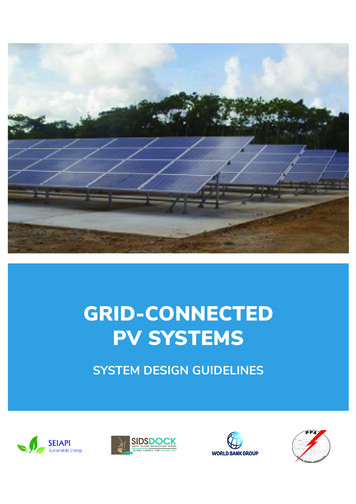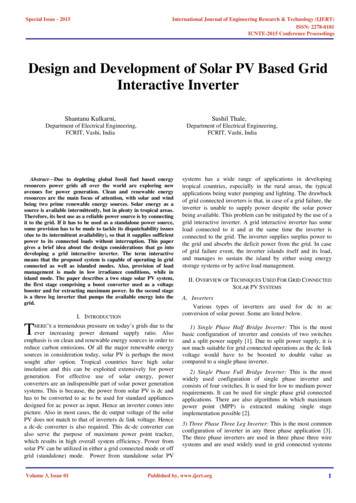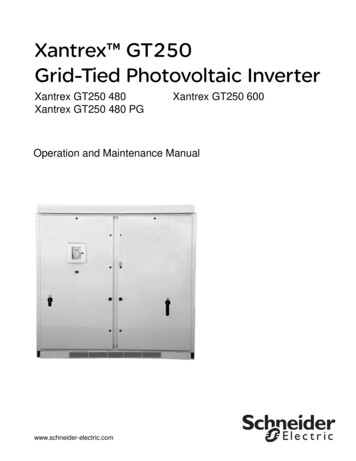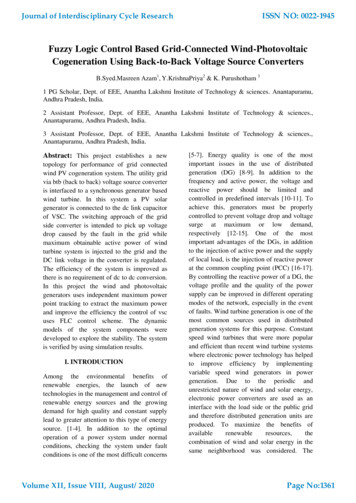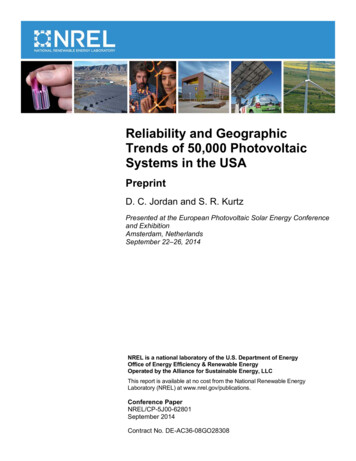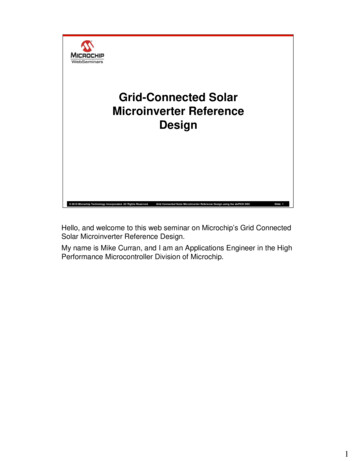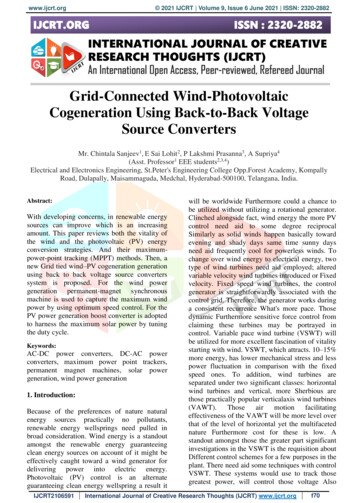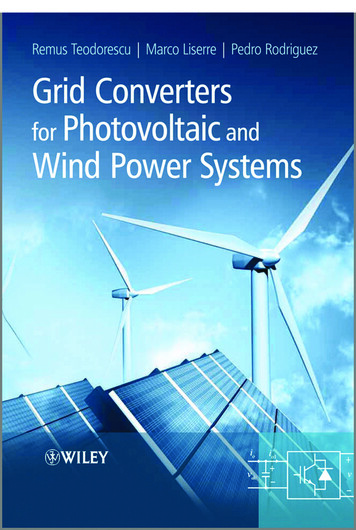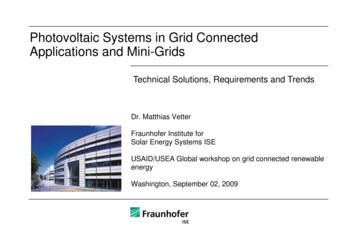
Transcription
Photovoltaic Systems in Grid ConnectedApplications and Mini-GridsTechnical Solutions, Requirements and TrendsDr. Matthias VetterFraunhofer Institute forSolar Energy Systems ISEUSAID/USEA Global workshop on grid connected renewableenergyWashington, September 02, 2009
Fraunhofer Institute for Solar Energy Systems ISEDirector:Prof. Eicke R. WeberStaff: 830Budget: 52.4 millionEstablished: 19812
Fraunhofer ISEResearch & Development, sComponentsProducts, PrototypesSystems, ProcessesServicesConsulting, TestsMonitoringQuality Assurance3
Fraunhofer ISE Areas of Business Energy-Efficient Buildings and Technical BuildingComponents Applied Optics and Functional Surfaces Solar Thermal Technology Silicon Photovoltaics Alternative Photovoltaic Technologies Renewable Power Generation Hydrogen Technology4
Test Facilities Solar Cell Calibration Laboratory (ISE CalLab) PV Module Calibration Laboratory (ISE CalLab) VDE-Fraunhofer ISE Test Center for Photovoltaics (TZPV) Testing Center for Thermal Solar Systems (PZTS) Thermal-Optical Measurement Laboratory (TOPLAB) Battery Testing Laboratory (BTL)5
Revenue Structure, Operation 2008Operation:Investment: 40.2 million 14.4 millionTotal: 54.6 millionIndustry42%Fed. Gov. Projects28%Regional Gov. Projects1%European Union6%Others14%Special Programs, FhG3%Basic Funding*6%* of which90% Federal Government10% Regional Government, BWStatus: 14 May 20096
Photovoltaic Systems in Grid Connected Applications andMini-Grids Systems: Small distributed systems, PV plants, PVbackup systems, PV in mini-grids Standards and regulations Power quality Grid control / grid stabilization Feed-in tariffs, e.g. German renewable energy act Market developments Scenario of European PV industry association Vision for developing countries7
Distributed, grid-connected photovoltaic systems House in Kirchzarten,Germany8
Distributed, grid-connected photovoltaic systems Central train station inFreiburg, Germany9
System outline and application modes Small distributed systems simple structure of gridconnected PV systems:PV inverter grid mostly private operators in lowpower range Installations mainly on roofs Connected to low voltage gridPV generatorgenerator connection boxinvertermetersgrid connection box2151234534Image: Solarpraxis AG, Berlin, Germany10
Direct feed-in of electricity into the public grid1324512345PV generatorconnection boxDC cablingDC-AC invertermetersImage: Solarpraxis AG, Berlin, Germany11
Feed-in to an intermediate sub-grid (e.g. building)Example for meter readings:1 solar meter 100 kWh2 total consumption ofbuilding: 1000 kWh3 consumption meter:kWh29101344 delivery meter: 10 kWhImage: Solarpraxis AG, Berlin, Germany12
Requirements for grid feeding invertersLNphotovoltaic generatorinverterpublic utilityTechnical Requirements high efficiency simple system monitoring find and stay at MPP minimizing grid interference access to operating dataEconomic Requirements low pricehigh reliability simple technical solution heavy duty equipmentImage: SMA Regelsysteme GmbH, Niestetal, Germany13
Back-up systems with two energy meters AC Back up systems withseparate electricity metersfor generation andconsumptionSource SMA14
Back-up systems with two energy meters DC Back up systems withseparate electricity metersfor generation andconsumption and couplingof PV over chargecontrollerSource SMA15
Benefits in case of grid availabilityAbility to feed an active orreactive current intothe public grid Source SMA16
Customers benefits in case of grid failure Uninterrupted powersupply Extension of autonomoustime with support fromrenewable energiesSource SMA17
Large systems for commercial business operation Commercial operators onlyin high range: 100kWp Installed on the ground, onflat roofs or integrated intobuildings Direct feed-in to themedium-voltage grid Additional benefitspossible (peak load supply,voltage stabilization)18
Grid-connected photovoltaic power plant (Freiburg)Photo: Fraunhofer ISE, Freiburg, Germany19
Grid-connected photovoltaic power plants Concentrated photovoltaics CPVPhoto: Concentrix Solar20
Electrification based on next generation of hybrid PV minigrids Integration of different energysources (PV, Wind, Hydro, etc.) Least cost option Increasing quality of energyservices Promoting local infrastructureand economic development Complement to the nationalelectricity network / grid21
System analyses – Example Mexico Variation of modulepriceLevelised Energy Cost (LEC) f or dif f erent M ini-Grid-Syst ems0,8Total LEC [5,5USD/Wp]Reference case: 99 Households,classified in fourgroups, a rural clinicand a fish factoryDaily consumption:2849 kWhPeak power:200 kWDiesel price:0,7 /lTotal LEC [1USD/Wp]0,6[ / kWh] Total LEC 70%80%90%100%Solar share22
System designDC/AC mixed AC/DC ConverterCharge ControllersAC bus line 230 or 400 VMaster InverterandBattery chargerAC LoadsDC bus lineDC LoadsSource ARE23
Standardised communication concept Supervisory energymanagement system Intelligent components Power generation Battery management Demand-side Communication bus Standardised “universalenergy supply protocol” Modular, flexible andexpandable24
PV system with central invertermain DCswitchinvertergridImage: Solarpraxis AG, Berlin, Germany25
Series-connected PV system with string-orientated invertersmain DCswitchinvertergridImage: Solarpraxis AG, Berlin, Germany26
Parallel-connected PV system with string-orientated inverterinvertergridImage: Solarpraxis AG, Berlin, Germany27
PV system with module-integrated inverters For example the inverter isintegrated by themanufacturer into thejunction box of the moduleinverterinverterinvertergridImage: Solarpraxis AG, Berlin, Germany28
Standards and regulations for feed-in of electricity to the gridThe following rules and regulations apply for theinstallation and commissioning of grid-connectedphotovoltaic systems: legal and official regulations national and European regulations andstandards regulations for safety at work conditions and guidelines of the local orregional utility29
Standards and regulationsPV systems may have different national regulations and standards (buildingregulations, personal safety, etc.), however EU is trying to harmonize standards For example: DIN, VDE, CENELEC and IECstandards lightning and surge protection building regulations and authorization technical rules for constructions with glass conservation laws applying to historicbuildings30
Definitions: Power quality and voltage qualityPower quality adequate connection power to supply electricloads without reducing comfort and convenience continuous availability of the power required ateach connection point (e.g. power interruptionstotal 15 minutes per year in Germany)Voltage quality waveform and quality of grid voltage conformingto standards- frequency- average voltage level- transient effects- harmonics High quality is needed to ensure uninterruptedoperation and long lifetimes for equipment31
Source S. Reichert, ISE32
Source S. Reichert, ISE33
Source S. Reichert, ISE34
Source S. Reichert, ISE35
The Erneuerbare Energie Gesetz EEG in Germany(Renewable Energy Act) Grid operators are obliged to connect PV-plantsto their grids Fixed feed-in-tariff for 20 years Costs associated with connecting installations paythe operator of the PV system A compensation between all transmission gridoperators exists The costs are shared by all users36
The Erneuerbare Energie Gesetz EEG 2(Renewable Energy Act)New law eligible since 1.1.2009: Minimum for feeding into the grid 31.94 -Cent/kWhBuilding integrated: Up to 30 kWp : 43.01 -Cent/kWh Up to 100 kWp : 40.91 -Cent/kWh Up to 1 MWp : 39.58 -Cent/kWh Above 1 MWp : 33.00 -Cent/kWhDirect use by the operator up to 30 kWp:25.01 -Cent/kWh avoided costs of 21 -Cent/kWh (typicalprice in the low voltage grid)Annual decreasing for new installations in the next twoyears between 8-10 % in dependence of the size and theaccumulated installations37
Photovoltaic World Market 2008Italy150 MWp; 3%France150 MWp; 3%Portugal42 MWp; 0.6%Belgium20 MWp; 0.3.%Spain2600 MWp44%USA500 MWp9%Germany1500 MWp26%ROEU30 MWp; 0.5%Canada20 MWp; 0.3%Japan230 MWp; 4%China20 MWp; 0.3%South Korea150 MWp; 3%India70 MWp; 1%ROW220 MWp; 4%Australia40 MWp; 0.6%New installedPV Power2006: 1600 MWp2007:2008:2650 MWp( 66%)5750 MWp( 117%)Red Letters:Countries withFeed-in tariffschemesSlide courtesy G. Stryi-Hipp, January 2009,Source: Preliminary figures of different NationalPV Associations.38
PV-Installationnewly installed in Germanynewly installed worldwideMWp2000150010005000Source: EPIA, BSW1998200020022004200639
Path to Grid Parity in Germany (!)50feed-in tariff according to EEG45electricity tariff for end consumerwith increase of6%/year4%/year -cent/kWh4035302520Source: Prof. Weber, ISE2008200920102011201220132014201540
Price learn curve of crystalline Si PV-modules[ /Wp]ηcell [%] 1015182022%1001980199020001020042007 (25%)20102020(30%)1d [µm] 40010-410-3Source: Prof. Weber, ISE10-230010-1120010010Installed Peak Power (cumulated) [GWp]5010210341
Policy driven scenario of European PV industry association EPIA“The policy drivenscenario is based onthe assumption of thefollow-up andintroduction of supportmechanisms, namelyFiT, in a large numberof countries.”Source: EPIA42
Energy supply system with distributed power generationnuclearpower plantlarge hydropower plantcoal firedpower stationhouse gridhouse gridwind powerhigh voltage gridmedium voltage gridlow voltage gridPVfuel cellImage: Fraunhofer ISE, Freiburg, Germanystoragebatterylarge PVgeneratorPV generator CHP (combined heatand power unit)43
Vision: Interconnection of hybrid PV mini-gridsSource: J. Luther, E. Kituyi: International Science Panelon Renewable Energies (ISPRE) - A Scientific Panel in Formation Support weak grids Security of supply via PVbackup systems Independence of fossil fuels44
Thanks for your attention45Contact:Dr. Matthias Vettermatthias.vetter@ise.fraunhofer.de
Standards and regulations for feed-in of electricity to the grid . The following rules and regulations apply for the installation and commissioning of grid- connected photovoltaic systems: legal and official regulations national and European regulations and standards regulations for safety at work conditions and guidelines of the local or
